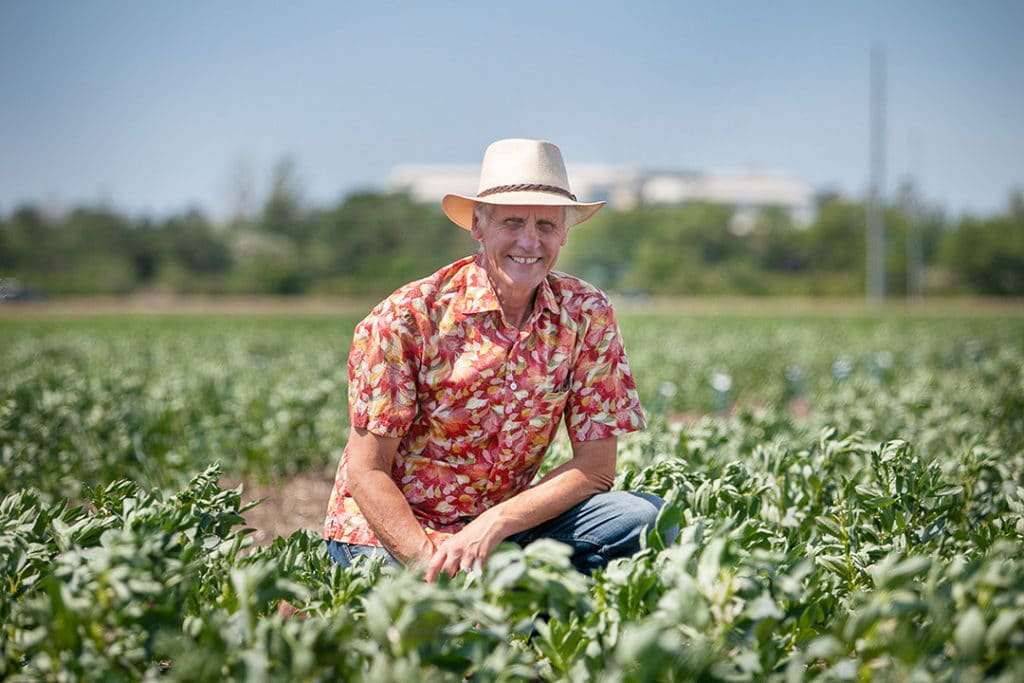The world of Canadian pulses just got more competitive thanks to the work of the Prairie Grain Development Committee (PGDC).
At is February meeting held in Winnipeg, Man., the PGDC’s Prairie Recommending Committee for Pulses & Special Crops (PRCPSC) voted to go “low vicine.” Moving forward, breeders of faba beans will need proof that their faba bean line contains low vicine levels in order to enter into faba bean trials.
“It’s pretty significant,” says PRCPSC chair Glen Hawkins, who also serves as seed production manager and pulse breeder for DL Seeds. “We thought it a good way to brand Canadian faba beans. As we move more into pulse-based food and food products, safety is always at the forefront.”
Vicine — and a related compound called convicine — is an alkaloid found in faba beans that is toxic to people who, due to genetic factors, lack an enzyme called glucose-6-phosphate dehydrogenase. Consuming vicine and convicine in high quantities can cause anemia in these individuals.
“The thought is as we get more into processing of pulses, when you concentrate protein and starch you concentrate vicine and convicene as a result. A few years ago, the request was made that we look to adopt a low vicine background in all faba beans,” Hawkins says.
It’s smart to go low vicine across the board, he notes. “Faba beans are an outcrossing crop, so if you have a vicine-containing line down the road and some bees around, you get outcrossing to the low vicine lines.”
As a result of the decision, in the next five to seven years, Canada’s faba bean acreage on the Prairies will consist of 100% low vicine lines, Hawkins says.
It’s the kind of big picture thinking that’s becoming more prevalent as the agricultural industry in Canada looks to become even more competitive on a global scale, a theme that was evident at this year’s PGDC meetings. PGDC chair Mitchell Japp said the importance of the connection between breeding innovation and agronomic adaptation was a crucial thought in designing this year’s plenary session.
“It’s crucial to draw the connections between those two worlds,” Japp says. “Profitability and sustainability are well connected.”
Going on across the street right before the PGDC meeting this year was the 9th Canadian Barley Symposium, where a major topic of discussion was the need to increase communication among stakeholders to ensure better variety uptake.
“That’s big,” Japp says. “That communication between end users, the seed industry and farmers has been lacking. We saw a failure there with CDC Meredith, where it ramped up in acres and then collapsed because end users felt it didn’t meet their needs. If we can get those lines of communication open, we don’t have the same level of risk involved in ramping up varieties in terms of making them available to both seed growers and producers.”

Maximizing Potential
According to Dana Maxwell, chair of the Prairie Recommending Committee for Wheat, Rye and Triticale, the hunt for wheat varieties that have good end use quality even under tough harvest conditions continues in earnest. AAFC breeder Richard Cuthbert put forward a CWRS line called BW5044. Grain yield of BW5044 averaged over 37 site years in the Western Bread Wheat Co-op Registration Test was 9% higher than Carberry with comparable protein.
The Fusarium head blight (FHB) response of BW5044 has been excellent with ratings of resistant to moderately resistant. BW5044 expresses resistance to prevalent races of stripe rust, leaf rust, stem rust, loose smut and common bunt. Based on the data generated for BW5044, it would be a major benefit to farmers in Western Canada — especially, in the high productivity areas of the prairies where FHB and rusts are a concern — while satisfying end use requirements of the CWRS class, Cuthbert notes.
He pointed to the results of a University of Manitoba study on CWRS wheat gluten strength presented at the PGDC meetings as proof that the market class system works well to identify and classify lines based on the end use quality traits that are of interest to customers.
The study carried out by researchers Harry Sapirstein and Paul Bullock looked at the relationship between genetics, environment and crop management on gluten strength and found that these relationships are complex. One takeaway from the study was that some CWRS varieties display a capability to minimize environmental influence on gluten strength.
About six years ago, the CWRS gluten strength targets were revised and harmonized across the agro-ecological regions of the Prairies, notes Cuthbert. The research shows that Carberry and AAC Brandon as well as some other older CWRS varieties, when considered at 27 site years, are not significantly different for gluten strength.

“If this study was to be continued with recently registered varieties, I suspect we would see higher levels of gluten strength and they would fall between Glenn (upper acceptable) and Carberry (lowest acceptable) for gluten strength,” Cuthbert says.
The registration system provides a tremendous opportunity to support registration of wheat varieties as well as the end use classification, he adds. He notes that AC Harvest was found to be significantly weaker than Carberry in the study, supporting its removal from the CWRS class.
“We do need to remain cognizant of where varieties are produced and the threats faced by producers as these can affect gluten strength negatively, but this shows our system works well when it comes to identifying wheat varieties that results in a good final end product.”
When paired with the right agronomic practices, farmers have an edge in closing the yield gap and getting the most from the wheat varieties they grow. Sheri Strydhorst, agronomic research scientist with Alberta Agriculture and Forestry, notes that as breeders push the yield potential of new varieties, farmers need to intensify their agronomic practices to realize those potential yield gains.
“New CWRS wheat varieties, with intensive agronomic management, can occasionally achieve field yields of 100+ bushels per acre, but on average in Western Canada farmers are not achieving that yield potential. While 100 bushels per acre is not achievable on every field in every year, more intensive agronomic management could be used in the right situations to allow growers to maximize the yield potential that breeders put into these varieties,” she says.
New Tools, Old Rules
But as breeding technologies like gene editing enable breeders to do new and exciting things with crop varieties, the industry needs regulatory clarification that right now is lacking. The Canadian Food Inspection Agency (CFIA) is working on making improvements to its regulatory programs for gene editing technology in plants, but there still haven’t been any results released or specific proposals made.
“While all of this talk and all of this discussion has been going on, Canada has been falling further and further behind our trading partners and like-minded countries in terms of the regulatory clarity,” Krista Thomas, vice-president trade policy — seed innovation with the Canada Grains Council, said during her talk at the plenary session.
“We‚Äôre headed into another growing season without the results of this work yet available to help encourage research and innovation in Canada and that’s unfortunate.”
The premarket regulatory requirements for novel plant products have posed a challenge for Canadian plant breeders, with Thomas saying these regulations can double the cost of producing a new variety and add an extra two years onto development before it hits the market. A recent survey of plant breeders in Canada, done by Stuart Smyth at the University of Saskatchewan, found about half of respondents have chosen not to pursue a research project in the past if they thought it might result in a novel trait.
“We need this guidance urgently. This guidance needs to be updated based on everything we‚Äôve learned about the safety of plant breeding in the last 20 years, and frankly it needs to take into account the practices that plant breeders already do to ensure the varieties that they‚Äôre bringing forward ear safe and fit for purpose,” Thomas says.
There is work being done to clarify the regulations, said Kenneth Ellens, plant biosecurity policy specialist with CFIA. The department has been working on improving guidance documents to help clarify which products are regarded as novel.
“We are working to clarify our regulatory triggers so product developers can have more confidence in their self determination of whether their product is considered novel or not. This is consistent with our goal of adding more predictability to the Canadian regulatory path.” Ellens says. The lack of clarity is hindering Canadian plant breeding, Thomas added.
“The reason why we need gene editing — CRISPR — is it’s a transformational tool, it’s a tool that touches on many wider areas of public policy, meeting consumer demand for higher healthier high-quality food, helping farmers adapt to climate change, to do more with less.”
For full info on the lines put forth at this year’s PGDC meetings visit pgdc.ca.













